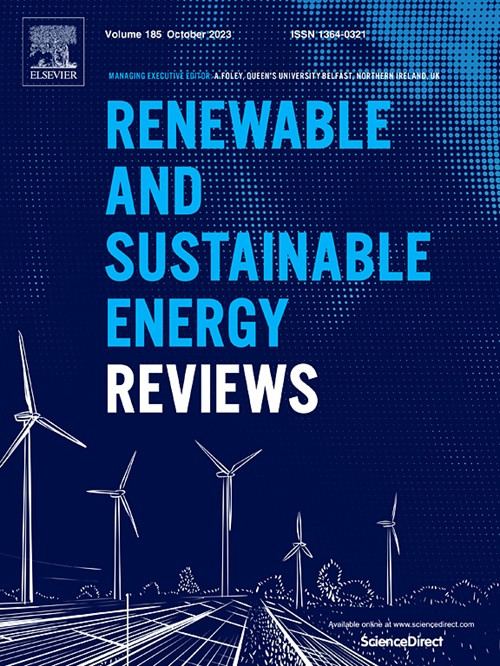废轮胎高能增值技术的最新进展:热化学和综合工艺、挑战和未来方向的系统综述
IF 16.3
1区 工程技术
Q1 ENERGY & FUELS
引用次数: 0
摘要
废旧轮胎的不断增加给环境带来了巨大的负担,凸显了废旧轮胎增值的紧迫性。本文综述了包括焚烧、热解和气化在内的高能气化技术的最新进展。通过实验和理论研究,得出了关键因素与产品之间的内在相关性。本文回顾了协同增值研究,以评估协同效应。最后,为了生产多种增值产品和减少对环境的负面影响,引入了多联产技术。可以观察到,由于缺乏后处理装置而导致的大量逃逸污染物破坏了焚烧过程的竞争力。废轮胎的热解和气化过程复杂且成本高昂,但其产品更有价值,这凸显了通过优化操作条件提高效率和盈利能力的潜力。高能共增值工艺具有提高产品质量和降低能耗的优点。在多联产过程中,氢气生产是市场青睐的一种更常见的选择。针对当前废轮胎能量增值面临的挑战,提出了更新预处理技术以提高整体效率、建立考虑多维分析和可持续发展目标(sdg)的综合评估模型、开发上层结构优化框架、收集机制数据以提高预测准确性等建议。本文综述了该领域的研究进展和未来发展方向,强调了能量增值技术对废轮胎可持续管理的重要意义。本文章由计算机程序翻译,如有差异,请以英文原文为准。
Recent advances of energetic valorization technologies for waste tires: A systematic review of thermochemical and integrated processes, challenges, and future directions
Increasing amounts of waste tires have constantly placed a huge burden on the environment, highlighting the urgency of waste tires valorization. This review aims to provide an overview of recent advances in energetic valorization technologies including incineration, pyrolysis, and gasification. The underlying correlations between critical factors and products are concluded based on experimental and theoretical studies. Co-valorization studies were reviewed to assess the synergistic effects. Lastly, poly-generation has been introduced for the production of multiple value-added products and for reducing negative environmental impacts. It can be observed that large amounts of escaping pollutants resulting from the lack of aftertreatment units undermine the competitiveness of the incineration process. Pyrolysis and gasification processes of waste tires are complex and costly, but the products are more valuable, highlighting the potential to improve efficiency and profitability by optimizing operation conditions. Energetic co-valorization processes have the advantages of enhancing the quality of products and reducing energy consumption. H2 production is a more common selection favored by the market in poly-generation processes. Some recommendations have been made to address current challenges faced by waste tire energetic valorization including updating the pretreatment techniques to improve overall efficiency, building comprehensive assessment models with consideration of multi-dimensional analysis and sustainable development goals (SDGs), developing superstructure optimization frameworks, and collecting mechanism data to enhance the accuracy of forecasts. This review outlines the achieved advances and future development directions in this field, underscoring the significance of energetic valorization technologies for sustainable waste tires management.
求助全文
通过发布文献求助,成功后即可免费获取论文全文。
去求助
来源期刊

Renewable and Sustainable Energy Reviews
工程技术-能源与燃料
CiteScore
31.20
自引率
5.70%
发文量
1055
审稿时长
62 days
期刊介绍:
The mission of Renewable and Sustainable Energy Reviews is to disseminate the most compelling and pertinent critical insights in renewable and sustainable energy, fostering collaboration among the research community, private sector, and policy and decision makers. The journal aims to exchange challenges, solutions, innovative concepts, and technologies, contributing to sustainable development, the transition to a low-carbon future, and the attainment of emissions targets outlined by the United Nations Framework Convention on Climate Change.
Renewable and Sustainable Energy Reviews publishes a diverse range of content, including review papers, original research, case studies, and analyses of new technologies, all featuring a substantial review component such as critique, comparison, or analysis. Introducing a distinctive paper type, Expert Insights, the journal presents commissioned mini-reviews authored by field leaders, addressing topics of significant interest. Case studies undergo consideration only if they showcase the work's applicability to other regions or contribute valuable insights to the broader field of renewable and sustainable energy. Notably, a bibliographic or literature review lacking critical analysis is deemed unsuitable for publication.
 求助内容:
求助内容: 应助结果提醒方式:
应助结果提醒方式:


